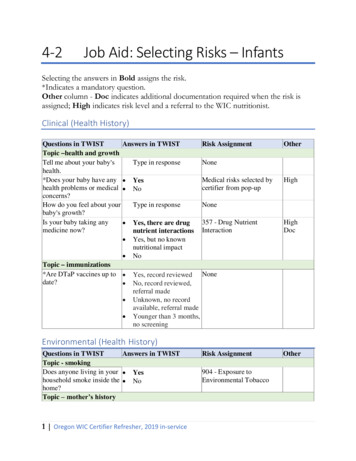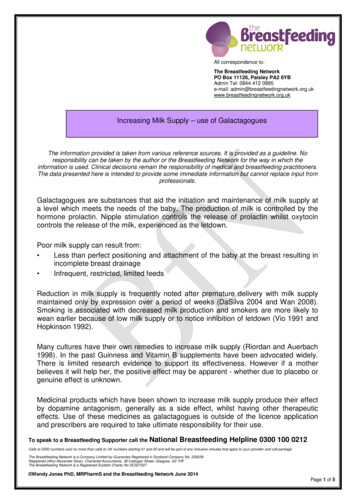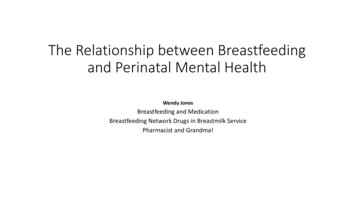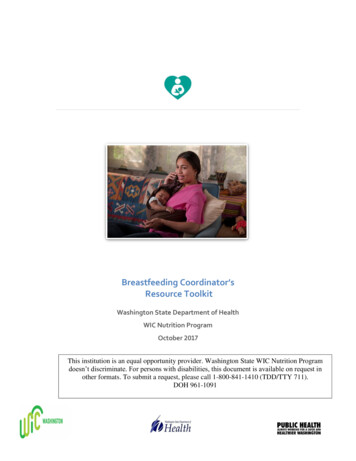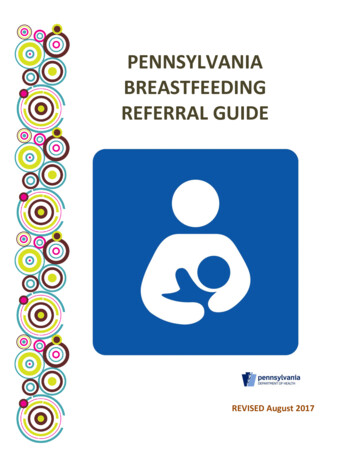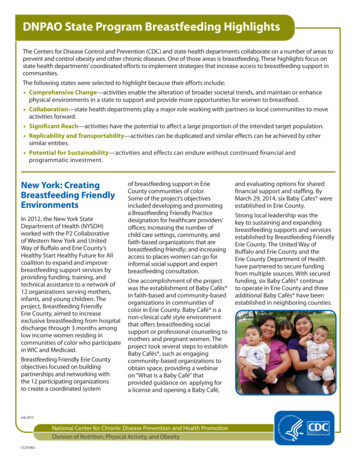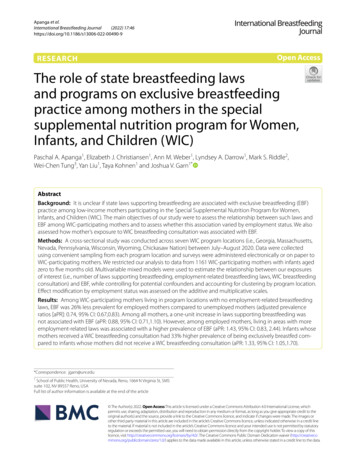
Transcription
Apanga et al.International Breastfeeding Journal(2022) n AccessRESEARCHThe role of state breastfeeding lawsand programs on exclusive breastfeedingpractice among mothers in the specialsupplemental nutrition program for Women,Infants, and Children (WIC)Paschal A. Apanga1, Elizabeth J. Christiansen1, Ann M. Weber1, Lyndsey A. Darrow1, Mark S. Riddle2,Wei‑Chen Tung3, Yan Liu1, Taya Kohnen1 and Joshua V. Garn1*AbstractBackground: It is unclear if state laws supporting breastfeeding are associated with exclusive breastfeeding (EBF)practice among low-income mothers participating in the Special Supplemental Nutrition Program for Women,Infants, and Children (WIC). The main objectives of our study were to assess the relationship between such laws andEBF among WIC-participating mothers and to assess whether this association varied by employment status. We alsoassessed how mother’s exposure to WIC breastfeeding consultation was associated with EBF.Methods: A cross-sectional study was conducted across seven WIC program locations (i.e., Georgia, Massachusetts,Nevada, Pennsylvania, Wisconsin, Wyoming, Chickasaw Nation) between July–August 2020. Data were collectedusing convenient sampling from each program location and surveys were administered electronically or on paper toWIC-participating mothers. We restricted our analysis to data from 1161 WIC-participating mothers with infants agedzero to five months old. Multivariable mixed models were used to estimate the relationship between our exposuresof interest (i.e., number of laws supporting breastfeeding, employment-related breastfeeding laws, WIC breastfeedingconsultation) and EBF, while controlling for potential confounders and accounting for clustering by program location.Effect modification by employment status was assessed on the additive and multiplicative scales.Results: Among WIC-participating mothers living in program locations with no employment-related breastfeedinglaws, EBF was 26% less prevalent for employed mothers compared to unemployed mothers (adjusted prevalenceratios [aPR]: 0.74, 95% CI: 0.67,0.83). Among all mothers, a one-unit increase in laws supporting breastfeeding wasnot associated with EBF (aPR: 0.88, 95% CI: 0.71,1.10). However, among employed mothers, living in areas with moreemployment-related laws was associated with a higher prevalence of EBF (aPR: 1.43, 95% CI: 0.83, 2.44). Infants whosemothers received a WIC breastfeeding consultation had 33% higher prevalence of being exclusively breastfed com‑pared to infants whose mothers did not receive a WIC breastfeeding consultation (aPR: 1.33, 95% CI: 1.05,1.70).*Correspondence: jgarn@unr.edu1School of Public Health, University of Nevada, Reno, 1664 N Virginia St, SMSsuite 102, NV 89557 Reno, USAFull list of author information is available at the end of the article The Author(s) 2022. Open Access This article is licensed under a Creative Commons Attribution 4.0 International License, whichpermits use, sharing, adaptation, distribution and reproduction in any medium or format, as long as you give appropriate credit to theoriginal author(s) and the source, provide a link to the Creative Commons licence, and indicate if changes were made. The images orother third party material in this article are included in the article’s Creative Commons licence, unless indicated otherwise in a credit lineto the material. If material is not included in the article’s Creative Commons licence and your intended use is not permitted by statutoryregulation or exceeds the permitted use, you will need to obtain permission directly from the copyright holder. To view a copy of thislicence, visit http:// creat iveco mmons. org/ licen ses/ by/4. 0/. The Creative Commons Public Domain Dedication waiver (http:// creat iveco mmons. org/ publi cdoma in/ zero/1. 0/) applies to the data made available in this article, unless otherwise stated in a credit line to the data.
Apanga et al. International Breastfeeding Journal(2022) 17:46Page 2 of 10Conclusions: Infants whose WIC-participating mothers were employed, were less likely to be exclusively breastfed,but our effect modification analyses showed that laws supporting breastfeeding at the workplace may promote EBFamong employed women. EBF was more prevalent among mothers who received a WIC breastfeeding consultationcompared to those who did not receive such a consultation.Keywords: Breastfeeding, Exclusive breastfeeding, Laws, Women, Infants, Children, Effect modificationBackgroundBreastfeeding is an important practice that providesnutrients for the optimal growth and development ofthe newborn [1]. Breastfeeding protects infants fromadverse effects of poor nutrition to enable them to obtaintheir full growth potentials [2]. The American Academyof Pediatrics affirms the importance of breastfeeding,and recommends six months of exclusive breastfeeding (EBF), followed by continued breastfeeding as complementary foods are introduced, with continuation ofbreastfeeding for one year or longer as desired by motherand infant [3].Though breastfeeding initiation and duration hasimproved among mothers in the US over time, 60% ofwomen do not breastfeed for as long as they intend to[4]. While 83.9% of infants in the United States (US) haveever been breastfed, only 25.8% of infants born in 2018were exclusively breastfed for 6 months, and 35.0% ofinfants were breastfeed for 1 year [5]. The low breastfeeding prevalence has been attributed to a number of physical/medical and social barriers. Physical/medical barriersinclude inadequate milk supply, breast pain and lactationproblems, Cesarean sections [6], and that breastfeedingis time intensive, which may make it difficult for mothersto practice EBF in the workplace [7]. Social barriers thatprevent mothers from meeting their breastfeeding goalsinclude lack of support from employers and child carefacilities, poor family and social support, lack of knowledge about breastfeeding, feeling embarrassed to breastfeed in public places, and lack of peer support duringbreastfeeding [6]. Overcoming barriers to breastfeedingin the US is essential, particularly in meeting the HealthyPeople 2030 goal of increasing the proportion of infantswho are exclusively breastfed through age 6 months to42.4% [8].A number of US laws have been enacted at the stateor federal levels supporting breastfeeding and potentially addressing some of the aforementioned barriers.The enactment of the federal law on Patient Protectionand Affordable Care Act in 2010 requires employersto provide “reasonable break time” and space to support breastfeeding mothers [9]. However, this law covers only employees who work for hourly wages, allowsmothers only to express breast milk, and exempts smallbusinesses [9, 10]. Some working mothers have soughtlegal protection using federal laws in order to breastfeed in the workplace, but have had little success insecuring the ability to breastfeed [9]. Most laws supporting breastfeeding in the US are enacted at the statelevel [9, 11]. State laws encourage breastfeeding in theworkplace, and prohibit employers from discriminating against breastfeeding employees. These laws alsoexempt mothers who breastfeed from public indecency laws and from jury duty, and protect them tobreastfeed in any public or private space [11]. Hawkinset al. observed that state laws supporting breastfeeding appear to increase breastfeeding rates, while Koganand his colleagues found that children in states withoutbreastfeeding laws were associated with higher oddsof not being breastfeed [10, 12]. State laws supportingbreastfeeding, which include having break time andhaving a private space at the workplace to breastfeed,have been associated with mothers being more likelyto breastfeed for six months [13]. However, the association between laws supporting breastfeeding and EBFhas not been well characterized among low-incomewomen living in the USA and participating in the Special Supplemental Nutrition Program for Women,Infants, and Children (WIC) program.WIC is a nutrition assistance program that safeguardsthe health of low-income pregnant and post-partumwomen, breastfeeding women, infants, and childrenyounger than five years by providing nutritious foods tosupplement diets, information on healthy eating, andreferrals to seek health care [14]. The program startedas a pilot program enacted by the Child Nutrition Act of1966 and now serves nearly one half of all infants bornin the US [14]. One of the key priorities of the programis to support breastfeeding among participating mothers and infants in accordance with the recommendationof the American Academy of Pediatrics so that mothersand children can benefit from the short- and long-termhealth benefits of breastfeeding [3, 14]. While some studies observed lower prevalence of breastfeeding practicesamong WIC mothers compared to eligible non-WICmothers [15, 16], others have found a positive relationship between WIC mothers and breastfeeding rates [17,18]. We use the term “WIC mothers” to refer to womenwho participate in WIC, for example, by receiving nutritious foods, referrals and counseling.
Apanga et al. International Breastfeeding Journal(2022) 17:46Our goal in this study was to estimate the strength ofassociation between WIC program locations’ (i.e., Georgia, Massachusetts, Nevada, Pennsylvania, Wisconsin,Wyoming, Chickasaw Nation) breastfeeding laws andWIC mothers EBF prevalence, and to assess whether therelationship with employment-related laws was modifiedby employment status. We hypothesized that WIC mothers living in program locations that have laws supportingbreastfeeding are more likely to report EBF comparedto WIC mothers in locations with fewer breastfeedinglaws. We also assessed how mothers’ exposure to WICbreastfeeding consultation is associated with EBF, andassessed whether this relationship is modified by employment status. We hypothesized that mothers who receiveda WIC breastfeeding consultation (i.e., receiving breastfeeding information from a WIC staff member, lactationconsultant or peer counselor) are more likely to practiceEBF compared to WIC mothers who did not receive thisinformation, and that this relationship will be modifiedby employment status.MethodsStudy design, data collection and study populationThis was a cross-sectional study conducted in sevenWIC program locations in six states (i.e., Georgia, Massachusetts, Nevada, Pennsylvania, Wisconsin, Wyoming)and in one Indian Tribal Organization (ITO; Chickasaw Nation, located in Oklahoma) between July 2020and August 2020. In the overarching study, data werecollected among WIC mothers of young children andexpectant mothers in their third trimester aged 18 yearsold or above as part of a baseline survey of a one-yearbreastfeeding campaign in the six states and the ITO [19].The campaign builds on the proven strengths of a socialmarketing approach for breastfeeding promotion amongWIC mothers. The campaign interventions include socialmarketing activities, the buddy program (a program thatmatches breastfeeding WIC mothers or expectant mothers whose babies were born or will be born around thesame date to share experiences, encourage each other tobreastfeed, and celebrate their children’s milestones) [20],and WIC clinic staff education. However, in this study,we restricted our study population to WIC mothers withinfants aged 5 months old or less, as this is the age groupof infants who are recommended to be exclusively breastfed according to the American Academy of Pediatrics [3].Sampling strategyParticipants for the study were recruited using a convenient sampling approach. The WIC staff in the six statesand the ITO administered the surveys either electronically through an online survey application or on paperto WIC-participating mothers. Responses to both onlinePage 3 of 10and paper surveys were de-identified. WIC staff members in each program location kept the list of WIC participants numbers onsite and assigned a project ID toparticipants for use on the surveys. While responses tothe online survey application went directly into a survey application, responses to the paper surveys wereentered into the survey application by WIC staff. Datawere collected on self-reported intention to breastfeed(but reported after birth), breastfeeding-related practices, obstetric characteristics, and socio-demographics.Data also were collected on breastfeeding services andresources available through the WIC program.Primary outcomeThe primary outcome of interest is EBF, which wasdefined as the mother feeding her infant only breastmilkup through 5 months of age.PredictorsThe predictors of interest in our study include laws supporting breastfeeding and WIC breastfeeding consultation. Employment status was assessed as an effectmodifier.Laws related to the promotion of breastfeeding ineach state or ITO were assessed by extracting datafrom the US National Conference of State Legislatures(NCSL) on breastfeeding laws, which provides a summary of breastfeeding laws from 50 states, the Districtof Columbia, Puerto Rico and the Virgin Islands, as ofSeptember 2020 [21]. Program coordinators confirmedthat laws in Chickasaw Nation were similar to those inOklahoma, the state that surrounds Chickasaw Nationon three sides. We categorized laws supporting breastfeeding into five themes: (1) employers are encouragedor required to provide break time and private space forbreastfeeding employees; (2) employers are prohibitedfrom discriminating against breastfeeding employees; (3)breastfeeding is permitted in any public or private location; (4) breastfeeding is exempt from public indecencylaws; and (5) breastfeeding women are exempt from juryduty (Additional file 1) [11]. The number of laws supporting breastfeeding in each state or ITO were summed tocreate a continuous score (i.e., a score of 1 for each themeand the total score range from 1 to 5). Breastfeeding lawsin themes (1) and (2) were grouped together as employment-related laws. A binary indicator was created forwhether the states or ITO had any employment-relatedbreastfeeding laws or not. WIC breastfeeding consultation was defined as mothers who self-reported that theyreceived breastfeeding information from a WIC programstaff member, lactation consultant or peer counselor (yes,no). Employment status was also self-reported, and wedichotomized employment into any employment versus
Apanga et al. International Breastfeeding Journal(2022) 17:46no employment. Mothers were considered employed ifthey reported being employed full-time or part-time.CovariatesThere were both individual- and program-level covariates. Individual-level factors include mother’s age (years),education ( high school graduate, high school graduate), marital status (married/living with partner, single), has an adult support for baby at home (yes, no),current smoker (yes, no), and infant age ( 8 weeks,8–16 weeks, 16 weeks). Other individual-level factorsinclude the mother’s previous history of breastfeeding(yes, no), parity (primiparity, multiparity), infant wasdelivered by cesarean section (yes, no), and infant wasborn premature (yes, no). Program-level factors includewhether the mother received any breastfeeding promotional messages (yes, no), and whether she receivedbreastfeeding information from any breastfeeding support group (yes, no).Data analysisDescriptive statistics of the study population were stratified by program locations. The overall prevalence of categorical variables, and the means and standard deviationsof continuous variables are presented separately for eachof the program locations.We used four separate multivariable mixed models toconduct our analyses. Each of these models used modified Poisson regression with a robust variance estimatorto estimate the prevalence ratio, and accounted for clustering by program location using a random intercept.The first model assessed the relationship between thenumber of laws supporting breastfeeding in each program location and EBF, while adjusting for potential confounders, which include WIC breastfeeding consultation,individual- and program-level factors. Biologically plausible potential confounders were specified a priori andwere controlled for in the model (Additional file 2).The second model was used to estimate the relationship between program location’s employment-relatedbreastfeeding laws and EBF practice. We introduced aninteraction term (program location’s employment-relatedbreastfeeding laws*employment status) in the model andassessed effect modification by employment status onthe additive and multiplicative scales, while adjustingfor the number of laws supporting breastfeeding, WICbreastfeeding consultation, individual-and program-levelfactors.The third model assessed the association betweenWIC breastfeeding consultation and EBF practice,while adjusting for the number of laws supportingbreastfeeding, employment status and individual- andPage 4 of 10program-level factors. The fourth model was similarto the third but included an interaction term betweenWIC breastfeeding consultation and employment status (WIC breastfeeding consultation*employment status). Effect modification was assessed on the additiveand multiplicative scale, while adjusting for the samevariables as in model 3.Effect modification on the additive scale was assessedusing the relative excess risk due to interaction (RERI).The additive scale can reliably identify the correctgroup of individuals to intervene in order to achieve asignificant public health impact [22, 23]. Therefore, it isthe most appropriate public health measure for assessing effect modification on the additive scale. RERI is anextra risk due to interaction, which is estimated as thedifference between the (expected) effect based on thesummation of the separate effects of the two predictors under study and the (observed) effect in the jointexposure category [24]. When RERI is equal to zero, itmeans no interaction, while a RERI greater than zeromeans positive interaction, and a RERI less than zeromeans negative interaction [25]. The RERI and corresponding 95% confidence intervals were estimatedusing publicly available SAS code [26]. On the multiplicative scale, an estimate of one means no effectmodification, and an estimate of less than one signifiesnegative effect modification and an estimate greaterthan one signifies positive effect modification [27]. Oureffect modification results were presented in a tabularformat recommended by Knol and VanderWeele [27].While we did not assess the role of each of the specific breastfeeding laws on EBF, we did conduct sensitivity analyses to compare the prevalence of EBF amongmothers in program locations with laws encouraging orrequiring employers to provide break time and privatespace for breastfeeding employees to mothers in program locations without such laws. We also comparedthe prevalence of EBF among mothers in program locations with laws that prohibit employers from discriminating against breastfeeding employees to mothersin program locations that do not prohibit such discrimination. We conducted sensitivity analyses to seewhether the relationship between the number of lawssupporting breastfeeding and EBF remained the sameacross different infant age (0–1, 2–3 & 4–5 months)groups. We also conducted sensitivity analysis to assessthe relationship between a 10-unit increase in numberof law-years in each program location and EBF. Number of law-years was defined as the number of totalyears of laws enacted in each state (Additional file 1).Data analyses were conducted using SAS version 9.4(SAS Institute, Cary, NC).
Apanga et al. International Breastfeeding Journal(2022) 17:46ResultsOur study population consisted of 1161 mothers withinfants 5 months of age or less (Table 1). The mean ageof mothers and infants across seven program locationsranged from 19–27 years and 3–13 weeks, respectively(Table 1). The majority of mothers had received a WICbreastfeeding consultation across all program locations.Similarly, most mothers had at least a high school level ofeducation across all program locations. Caucasian/Whitemothers were majority in three of the program locations (Chickasaw Nation, Pennsylvania, Wyoming), whileHispanic mothers were more prevalent in two programlocations (Massachusetts, Nevada). Black/African mothers were majority in Georgia and Wisconsin. The prevalence of EBF ranged from 20% in Massachusetts to 69%in Wyoming. Mothers who reported any current breastfeeding ranged from 37% in Pennsylvania to 88% in Wyoming (Table 1). There was also little missing informationin our data (Table 1).Among all mothers, there was no relationship betweena one-unit increase in laws supporting breastfeedingand EBF (adjusted prevalence ratio [aPR]: 0.88, 95% CI:0.71,1.10; Table 2). A number of individual-and programlevel variables were associated with EBF among all mothers (Table 2). We found that Hispanic/Latina women had35% lower prevalence of EBF compared to Caucasian/White women (aPR: 0.65, 95% CI: 0.46,0.92). Motherswho smoke had 38% lower prevalence of EBF comparedto their peers that were not smoking (aPR: 0.62, 95% CI:0.44,0.87). EBF was also more prevalent among primiparous women compared to multiparous women (aPR: 2.12,95% CI: 1.43,3.12). In addition, EBF was 20% less prevalent among mothers that had a Cesarean section compared to mothers that had a vaginal delivery (aPR: 0.80,95% CI: 0.74,0.87). Infants whose mothers had a previoushistory of breastfeeding and received breastfeeding information from any support group were 2.71 and 1.30 timesmore likely to be exclusively breastfed, respectively, compared to infants whose mothers had no prior history ofbreastfeeding and did not receive breastfeeding information from any support group (Table 2).Our analysis on effect modification by employmentstatus on the relationship between employment-relatedbreastfeeding laws and EBF, found the estimate was inthe direction that supports a higher EBF prevalenceamong employed mothers, although the confidenceintervals included the null (aPR: 1.43, 95% CI: 0.83,2.44; Additional file 3). Among unemployed mothers,there was no difference in the prevalence of EBF amongmothers in program locations with employmentrelated breastfeeding laws and mothers in programlocations without employment-related breastfeedinglaws (aPR: 1.06, 95% CI: 0.64, 1.76; Additional file 3).Page 5 of 10Among mothers living in program locations with noemployment-related breastfeeding laws (Nevada, Pennsylvania, Wisconsin), EBF was 26% less prevalent foremployed mothers compared to unemployed mothers(aPR: 0.74, 95% CI: 0.67, 0.83; Additional file 3). Therewas no difference in the prevalence of EBF amongemployed mothers in program locations with employment-related breastfeeding laws and unemployedmothers in program locations without employmentrelated breastfeeding laws (aPR: 1.06, 95% CI: 0.63,1.78; Additional file 3). There were indications of effectmodification by employment status on the relationship between employment-related breastfeeding lawsand EBF on both the additive and multiplicative scales,but evidence on the multiplicative scale was stronger(aPR: 1.34, 95% CI: 1.01,1.78; Additional file 3). Theestimated effect on the additive scale of employmentrelated laws among employed mothers was larger thanthe estimated effect of employment-related laws amongunemployed mothers (RERI: 0.25, 95% CI: -0.02,0.53;Additional file 3).We also observed that mothers who received a WICbreastfeeding consultation had 33% higher prevalenceof EBF compared to mothers who did not receive aWIC breastfeeding consultation (aPR: 1.33, 95% CI:1.05,1.70; Model III; Additional file 4). The associationbetween WIC breastfeeding consultation and EBF wasnot modified by employment on either the additive ormultiplicative scales (Additional file 5).Our sensitivity analyses on specific individual breastfeeding laws found no strong evidence of associationbetween individual laws and EBF. Specifically, therewas no association between mothers in program locations with the law encouraging or requiring employersto provide break time and private space for breastfeeding employees and EBF (aPR: 1.18, 95% CI: 0.72,1.93).There was also no association between mothers in program locations with laws prohibiting employers fromdiscriminating against breastfeeding employees andEBF (aPR: 0.78, 95% CI: 0.61,1.00). Other sensitivityanalyses focusing on infant age specific associationsshowed there was also no relationship between thenumber of breastfeeding laws and EBF among infantsage ranges 0–1 month (aPR: 0.78, 95% CI: 0.61,1.00),or 2–3 months (aPR: 0.98, 95% CI: 0.71,1.36), and4–5 months (aPR: 1.05, 95% CI: 0.73,1.51). Our sensitivity analysis on the number of law-years found noassociation between a 10-unit increase in law-yearsin a program location and EBF (aPR: 1.07, 95% CI:0.91,1.25). We also conducted sensitivity analyses withmothers’ intention to exclusively breastfeed prior todelivery as a potential confounder and we got similarresults.
Apanga et al. International Breastfeeding Journal(2022) 17:46Page 6 of 10Table 1 Characteristics of mothers participating in WIC in seven program locations (n 1161)CharacteristicsCN*GA*MA*NV*PA*WI*WY*Total sampled10388895242561289Socio-demographic factorsMother’s age (years), mean (*SD)25 (5)26 (25)23 (28)27 (14)27 (10)19 (37)27 (5)Infant’s age (weeks), mean (SD)13 (8)12 (9)3 (2)11 (8)7 (4)8 (11)11 (8)Infant’s age (%) 8 weeks34 (33)33 (37)85 (96)216 (41)130 (51)8 (67)38 (43)8–16 weeks26 (25)19 (22)4 (4)133 (25)123 (48)1 (8)23 (26) 16 weeks43 (42)36 (41)0175 (33)3 (1)3 (25)28 (32)Education (%) High school graduate16 (16)7 (8)21 (26)99 (20)49 (20)2 (17)15 (17) High school graduate83 (84)78 (92)59 (74)409 (80)196 (80)10 (83)74 (83)4391611missingMarital status (%)Married/living with partner67 (68)42 (49)43 (54)317 (62)128 (53)9 (75)63 (71)Single32 (32)43 (51)37 (46)191 (38)115 (47)3 (25)26 (29)missing4391613Employment status (%)Unemployed62 (63)54 (64)57 (71)380 (75)154 (63)6 (50)60 (67)Employed37 (37)30 (36)23 (29)128 (25)89 (37)6 (50)29 (33)missing4491613Race/Ethnicity (%)Caucasian/White36 (36)3 (4)21 (27)102 (21)198 (86)2 (18)66 (76)Asian/Pacific Islander06 (8)2 (3)35 (7)1 (0)2 (18)0Black/African American2 (2)54 (69)7 (9)50 (10)15 (7)4 (36)0American Indian/Alaska Native28 (28)006 (1)002 (2)Hispanic/Latina6 (6)11 (14)39 (49)249 (51)4 (2)2 (18)14 (16)Multiracial27 (27)4 (5)5 (6)46 (9)11 (5)1 (9)4 (5)Other005 (6)2 (1)2 (1)01 (1)missingHas an adult support for baby (%)missingCurrent smoker (%)missing4101034251280 (81)54 (64)52 (64)357 (70)168 (69)9 (75)67 (75)1 (8)4 (5)438161311 (11)5 (6)7 (7)14 (3)44 (18)4381611Obstetric factorsParity (%)multiparity57 (55)57 (65)57 (64)353 (67)165 (64)12 (100)56 (63)primiparity46 (45)31 (35)32 (36)171 (33)91 (36)033 (37)34 (33)32 (36)29 (35)145 (28)82 (32)6 (50)21 (24)5328 (11)3 (25)8 (9)57 (22)5 (42)61 (69)Cesarean section (%)missingPrematurity (%)12 (12)15 (17)missing18 (21)43 (8)53Breastfeeding-related factorsExclusive breastfeeding (%)32 (31)27 (31)missing17 (20)202 (39)23Currently breastfeeding (%)51 (50)73 (83)56 (63)429 (82)95 (37)8 (67)78 (88)Ever breastfeed (%)88 (85)86 (98)71 (80)510 (98)173 (68)9 (75)87 (98)Received breastfeeding promotion (%)91 (88)71 (81)62 (70)418 (80)202 (79)9 (75)68 (76)History of breastfeeding (%)44 (43)46 (52)40 (46)304 (58)106 (41)10 (83)51 (57)missing1
Apanga et al. International Breastfeeding Journal(2022) 17:46Page 7 of 10Table 1 (continued)CharacteristicsCN*GA*MA*23 (23)29 (33)12 (14)43497 (95)66 (75)68 (80)469 (90)208 (83)434missingReceived information from any breastfeed‑ing support group (%)missingPA*WI*WY*102 (20)42 (17)4 (33)17 (19)10 (83)76 (86)1missingWIC breastfeeding consultation (%)NV*111*CN Chickasaw Nation, *GA Georgia, *MA Massachusetts, *NV Nevada, *PA Pennsylvania, *WI Wisconsin, *WY Wyoming, *SD Standard deviationDiscussionThe objective of this study was to assess the role ofbreastfeeding laws and programs on EBF among WICmothers. Our analysis found that the number of lawssupporting breastfeeding in a program location wasnot associated with a WIC mother’s EBF practice. Wefound that WIC mothers who were employed wereless likely to practice EBF compared to WIC motherswithout employment in program locations withoutemployment-related breastfeeding laws. However, EBFwas more prevalent among employed WIC mothers inworkplaces with laws supporting breastfeeding. EBFpractice was also more prevalent among mothers whoreceived a WIC breastfeeding consultation comparedto mothers who did not receive such a consultation.Our finding of a higher EBF prevalence amongemployed mothers working in program locationswith employment-related breastfeeding laws maylend support to the important role laws supportingbreastfeeding at the workplace can have at promotingbreastfeeding practice. The finding of no strong association between the number of laws supporting breastfeeding and EBF practice among all mothers could bedue to several reasons. Most states’ laws supportingbreastfeeding lacked enforcement provisions and fewof these laws have penalties for violations [11]. Enforcing laws supporting breastfeeding without penaltiesfor violations or incentives to encourage compliancemay render laws supporting breastfeeding less effective[11]. Another possible reason for our observed finding is that mothers may be unaware of laws supportingbreastfeeding and therefore could not take advantageof such laws to breastfeed [28]. Instances have beenreported of unawareness of the existence of laws permitting mothers to breastfeed in any public or privatelocation, and where mothers were told to stop breastfeeding or leave the vicinity of premises [29]. Mothers in such situations may stop breastfeeding becausethey feel embarrassed and afraid of being stigmatizedby the people around them [30, 31]. Another plausibleexplanati
to practice EBF in the workplace [7]. Social barriers that prevent mothers from meeting their breastfeeding goals include lack of support from employers and child care facilities, poor family and social support, lack of knowl-edge about breastfeeding, feeling embarrassed to breast-feed in public places, and lack of peer support during


